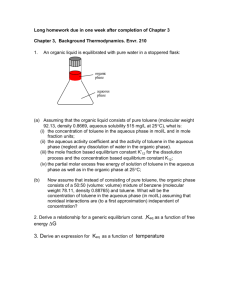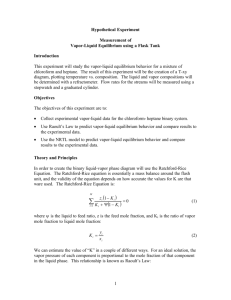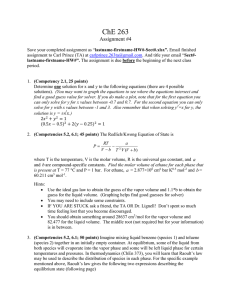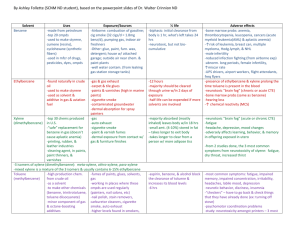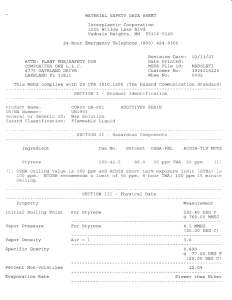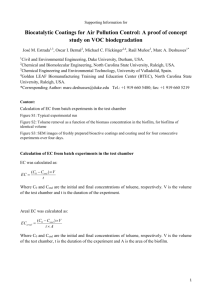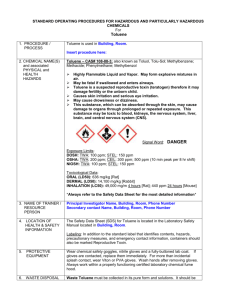Problem 6.52
advertisement
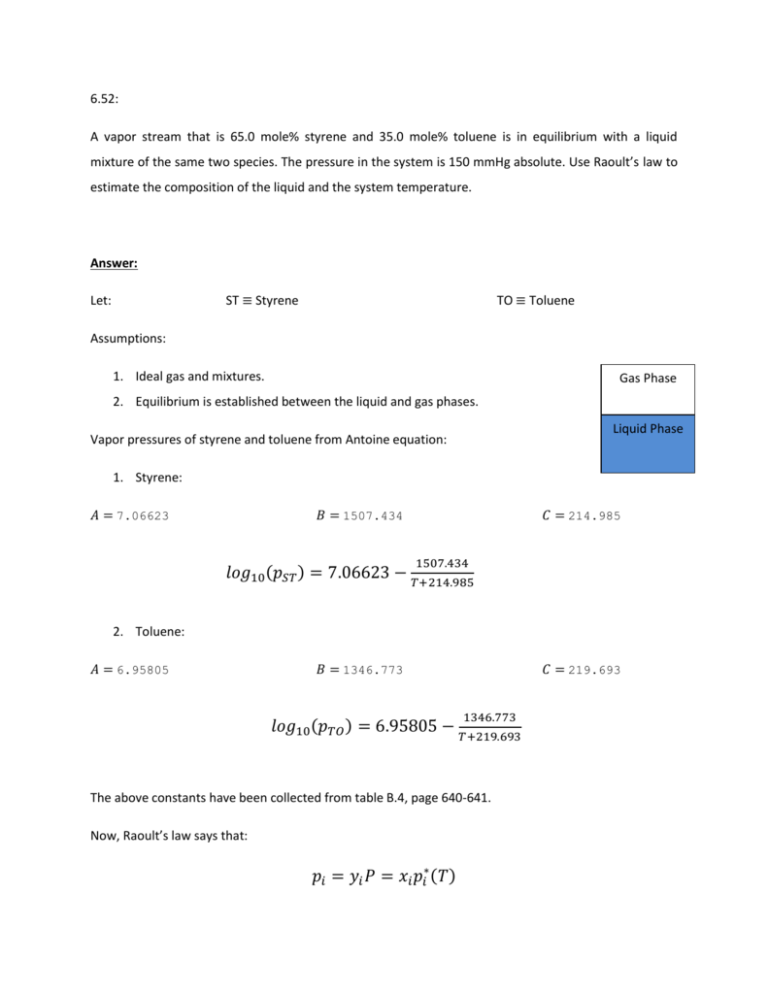
6.52: A vapor stream that is 65.0 mole% styrene and 35.0 mole% toluene is in equilibrium with a liquid mixture of the same two species. The pressure in the system is 150 mmHg absolute. Use Raoult’s law to estimate the composition of the liquid and the system temperature. Answer: ST ≡ Styrene Let: TO ≡ Toluene Assumptions: 1. Ideal gas and mixtures. Gas Phase 2. Equilibrium is established between the liquid and gas phases. Liquid Phase Vapor pressures of styrene and toluene from Antoine equation: 1. Styrene: 𝐴 = 7.06623 𝐵 = 1507.434 𝑙𝑜𝑔10 (𝑝𝑆𝑇 ) = 7.06623 − 𝐶 = 214.985 1507.434 𝑇+214.985 2. Toluene: 𝐴 = 6.95805 𝐵 = 1346.773 𝑙𝑜𝑔10 (𝑝𝑇𝑂 ) = 6.95805 − 𝐶 = 219.693 1346.773 𝑇+219.693 The above constants have been collected from table B.4, page 640-641. Now, Raoult’s law says that: 𝑝𝑖 = 𝑦𝑖 𝑃 = 𝑥𝑖 𝑝𝑖∗ (𝑇) In this problem, the gas phase composition is given and this leads to “dew point calculation. Now, we need to get rid of the liquid composition by acting smart and using the following properties: ∑𝑛𝑖=1 𝑥𝑖 = 1.0 It says that the summation of all mole fractions in the liquid phase should add to unity. Raoult’s law can be re-written as: 𝑥𝑖 = Apply now ∑2𝑖=1 𝑦𝑖 𝑃 𝑝𝑖∗ (𝑇) on both sides of the above equation to obtain: ∑2𝑖=1 𝑥𝑖 = ∑2𝑖=1 𝑦𝑖 𝑃 𝑝𝑖∗ (𝑇𝑑𝑝 ) Let’s expand it now considering the two components of interest: 𝑦𝑆𝑇 𝑃 ∗ 𝑝𝑆𝑇 (𝑇𝑑𝑝 ) + 𝑦𝑇𝑂 𝑃 ∗ 𝑝𝑇𝑂 (𝑇𝑑𝑝 ) = 1.0 Re-arrange it to obtain: 𝑓(𝑇𝑑𝑝 ) = 𝑦𝑆𝑇 ∗ 𝑝𝑆𝑇 (𝑇𝑑𝑝 ) 𝑦𝑇𝑂 1.0 − 𝑃 𝑇𝑂 (𝑇𝑑𝑝 ) + 𝑝∗ =0 So the dew point temperature is the temperature at which the above equation becomes zero. Let’s plot the above equation at some interval and check if it has a zero or not. Matlab is used and the function shows the following behavior: f(Tdp) vs. T 0.05 0.04 dp f(T ) 0.03 0.02 0.01 0 -0.01 40 50 60 70 80 90 100 110 120 130 140 150 160 o Temperature ( C) So it clear that the above function has a zero at a temperature equal to ≈87oC. Let’s now apply Newton’s method, i.e. explained in the class, to find exactly what would be that temperature. The procedure followed is: 1. Start with a new guess. 2. Calculate the values of the function 𝑓(𝑇𝑑𝑝 ) and the derivative 𝑓′(𝑇𝑑𝑝 ). 3. If the value of the function is not small to be accepted update the temperature by: 𝑇𝑑𝑝 = 𝑇𝑑𝑝 − 𝑓(𝑇𝑑𝑝 ) 𝑓′(𝑇𝑑𝑝 ) 4. Evaluate the values of the function and the derivative at the new temperature and go to step (3). The above procedure stops only when the value of the function is very close to zero. A summary of the result is given in the following table: 𝑇𝑑𝑝 50 66.1586107430237 78.9194092797095 84.978972627752 85.9889506291818 86.0123204472323 86.0123325474267 𝑓(𝑇𝑑𝑝 ) 0.024387321534317 0.00815435113933363 0.00209171716793117 0.000264756068262319 5.85739727803486×10-6 3.02964881394169×10-9 8.02309607639273×10-16 𝑓′(𝑇𝑑𝑝 ) -0.00150924617977112 -0.000639015741522037 -0.000345192722278729 -0.000262140430670271 -0.000250639404439956 -0.000250380176646247 -0.000250380042505033 f(Tdp) vs. T 0.05 f(Tdp) initial guess improved iterates Solution 0.04 dp f(T ) 0.03 0.02 0.01 0 -0.01 40 50 60 70 80 90 100 110 120 130 140 150 160 Temperature (oC) See in the above figure how the initial guess is improved till the final solution is reached. The system temperature is ≈86.01oC. The liquid composition is: 𝑥𝑆𝑇 = 𝑦𝑆𝑇 𝑃 ∗ (86.01) = 0.853 𝑝𝑆𝑇 𝑥𝑇𝑂 = 𝑦𝑇𝑂 𝑃 ∗ (86.01) 𝑝𝑇𝑂 = 0.147
